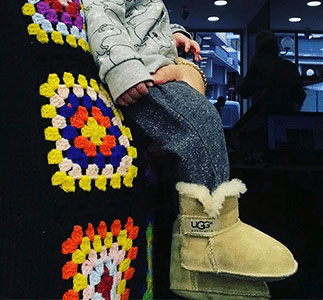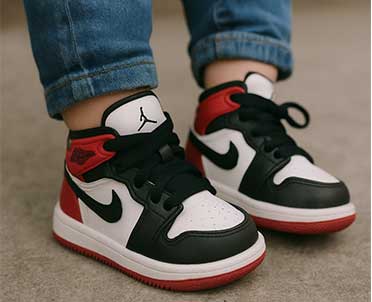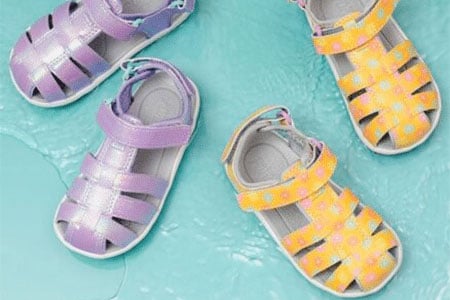Best Shoes for Toddlers Learning How to Walk – Lightweight, Flexible, and with Sensory Pods!

When it comes to your toddler’s first steps, finding the right pair of shoes is crucial. Did you know that certain first-walking shoes can help toddlers with balance? As a shoe fitter with years of experience, I have fitted hundreds of toddlers for their first pair of walking shoes, and I will show you a list of shoes that provide thin, flexible soles with sensory pods that allow natural movement and provide a sense of connection with the ground beneath them. In other words, the shoes I recommend help mimic the barefoot experience as closely as possible.
We will stay away from shoes that are too heavy or stiff, as this can make the process of your toddler learning how to walk a lot harder.
Is Your Toddler Ready to Wear Shoes?
Most toddlers start walking by 14 months, but if it’s taking a little longer for your toddler to learn how to walk you have nothing to worry about. I have seen toddlers that don’t start walking until they are 16 or 17 months. Even if your toddler is not walking yet, you may notice that your toddler can perform other motor skills with no problem, like standing alone, pulling up on furniture, and bouncing up and down.
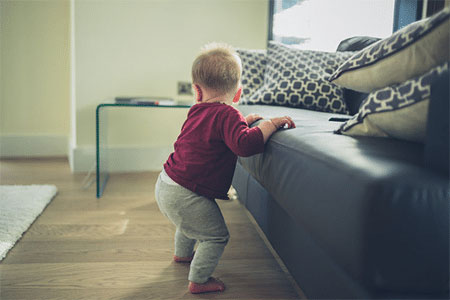
One common question parents ask me is: When is the correct time to get toddlers their first pair of walking shoes? This has always been a controversial matter. When toddlers begin to lift themselves and stand on their own power — this is somewhere between the seventh and tenth month — then it might be time to get them their first pair of walking shoes. If your toddler doesn’t walk by the age of 18 months, then it might be time to talk with your doctor.
Are Robeez a Good Choice for Your Baby?
Just so we are on the same page, Robeez is not a good shoe brand for toddlers who are learning how to walk. Robeez and other soft soled shoes are cute and wonderful for indoor use but won’t hold up in the elements. As far as specific shoe brand recommendations, Stride Rite, See Kai Run, and Tsukihoshi are my go-to shoe brands for toddlers who are learning how to walk as they manufacture the best fitting and versatile shoes available in different widths such as wide and extra wide.
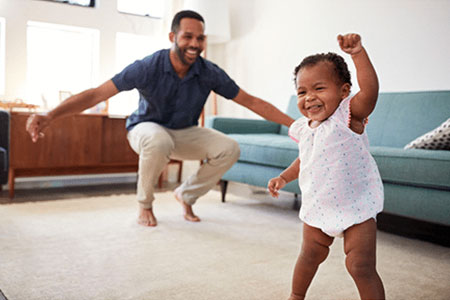
Always allow your toddler to go barefoot at home to promote healthy foot development. A pair of shoes comes into play when you take your toddler outside to the playground, shopping mall, or any other place that involves being outdoors.
Key Shoe Features for Toddlers Learning How to Walk
1. Flexible Soles: To make the process for your toddler who is learning how to walk easier, the soles of the shoes need to imitate barefoot walking as much as possible.
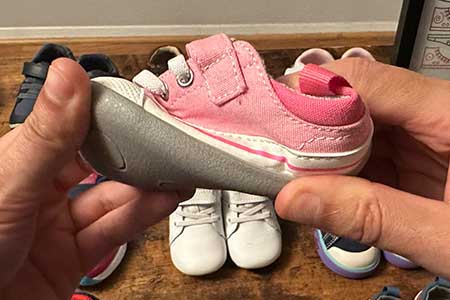
2. Soft Heel Counters: Toddlers who are learning how to walk perform a lot of lateral movements.
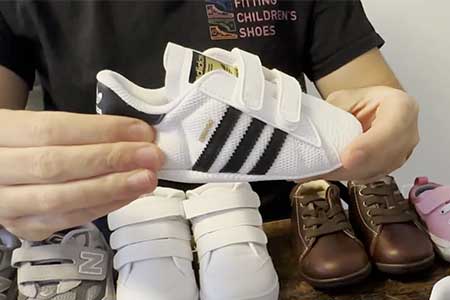
3. Sensory Pods: Sensory pods allow your toddler to feel the ground beneath for better traction and grip.
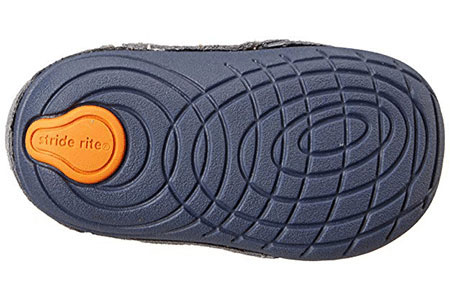
4. Flexible Rounded Soles: This feature encourages your toddler’s natural movement and helps improve the toddler’s balance. This feature also helps prevent stumbles and falls.
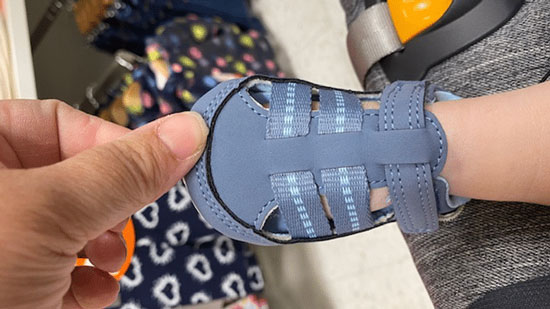
5. Breathable: This feature allows your toddler’s feet to breathe and prevents the formation and buildup of bacteria inside the shoes.
All of the shoes I recommend below have the ability to mimic the natural feel of walking without shoes while providing a layer of protection. These shoes are designed to encourage natural foot development, allowing little feet to move and flex as they would naturally, without the constraints of traditional footwear. This approach supports the development of strong foot muscles and improves balance and coordination.
By the way, the shoes I recommend below are capable of fitting toddlers with different foot shapes such as medium, wide, and extra wide feet. Disclosure: Some links in this post may be affiliate links and we may receive a small commission (at no extra cost to you) when you click our links and make purchases.
Shoes for Toddlers Learning How to Walk to Improve Balance
Brands like Stride Rite, See Kai Run, and Tsukihoshi offer excellent options tailored to the needs of new walkers, ensuring that your child’s feet are not restricted.
1. Shoe Style Stevie II by See Kai Run
The Stevie model is a popular choice among parents for its wide toe box and adjustable straps, making it an excellent option for kids with wide feet. The flexible sole and durable construction provide support without restricting movement.

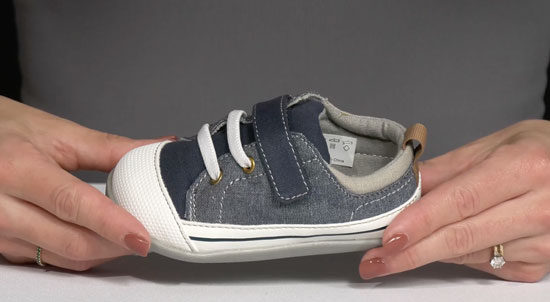
Key Features
- Available for toddlers.
- Order the shoe style Stevie II by See Kai Run on Amazon or Zappos.
- Not available in wide or extra wide widths but fits naturally wide.
- Awarded the Seal of Acceptance from the American Podiatric Medical Association (APMA).
- Durable cotton drill upper, comfy leather insole, and recycled mesh lining keep feet fresh.
- Breathable textile lining and cushioned insole.
- I suggest that you get this shoe a whole size larger than your toddler’s current foot size.
2. Shoe Style Thompson by Stride Rite
Stride Rite is a well-known brand in children’s footwear, and their Soft Motion Thompson model is perfect for toddlers who need a wide toe box. The shoe features a flexible sole and a rounded toe design to support natural movement, making it a favorite among parents and podiatrists alike.
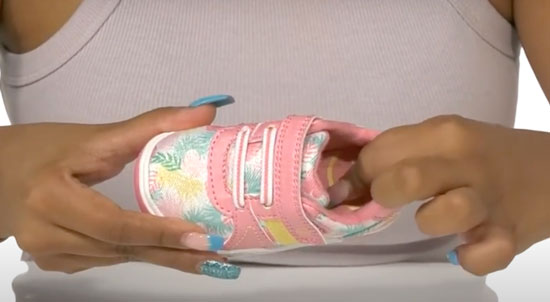
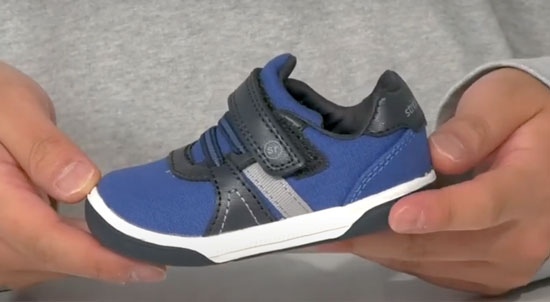
Key Features
- Available for toddlers.
- Order the shoe style Thompson Sneaker on Amazon
- Available in wide widths.
- Awarded the Seal of Acceptance from the American Podiatric Medical Association (APMA).
- Padded tongue and collar for added comfort.
- Breathable textile lining and cushioned insole.
- I suggest that you get this shoe a whole size larger than your toddler’s current foot size.
3. Shoe Style Racer by Tsukihoshi
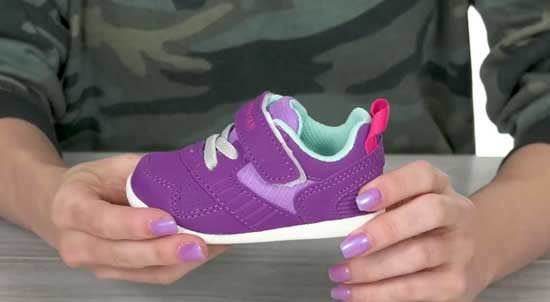
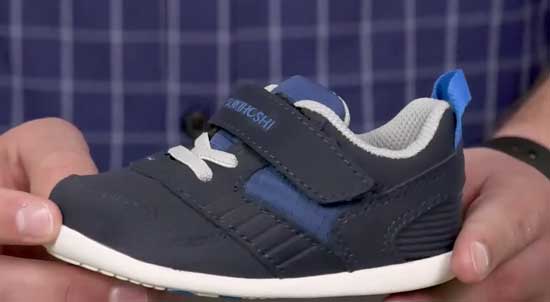
Key Features
- Available for toddlers.
- Order the shoe style Artie and Adalyn by Stride Rite on Amazon or Zappos.
- Rounded edges to decrease stumbles and falls.
- Available in wide and extra wide widths.
- I suggest that you get this shoe a whole size larger than your child’s current foot size.
4. Shoe Style Artie and Adalyn by Stride Rite
The Artie and Adalyn styles from Stride Rite provide excellent width options (wide and extra wide) and a comfortable fit. Their design includes flexible outsoles and cushioned insoles, which are essential for active toddlers.
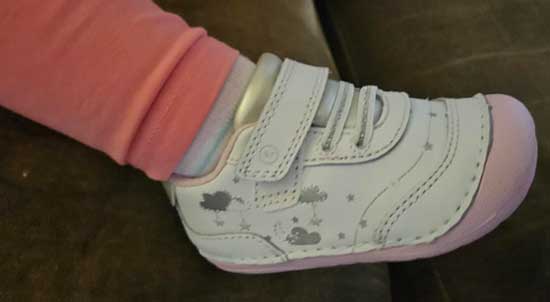
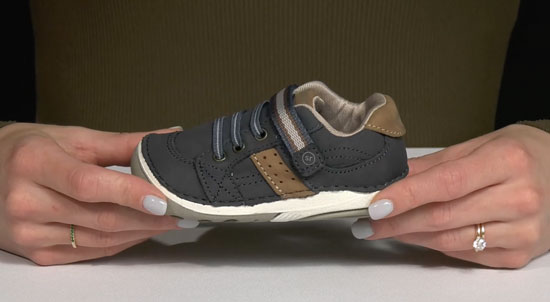
Key Features
- Available for toddlers.
- Order the shoe style Artie and Adalyn by Stride Rite on Amazon or Zappos.
- Rounded edges to decrease stumbles and falls.
- Available in wide and extra wide widths.
- I suggest that you get this shoe a whole size larger than your child’s current foot size.
5. Shoe Style Elliott by Stride Rite
These high-top booties by Stride Rite offer excellent support and a comfortable fit, making them a top choice for a toddler with flat feet and overpronation. This shoe is affordable and despite the limited color choices, the Elliott shoes are celebrated for their supportive qualities and comfortable fit.
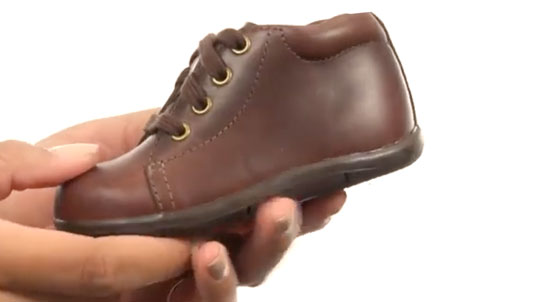

Key Features
- Order the shoe style SRT Elliot by Stride Rite on Amazon or Zappos.
- Available in wide and extra wide widths.
- 100% leather made.
- I suggest getting this shoe a whole size larger than your toddler’s current foot size.
6. Shoe style Archie and Kiki by Stride Rite
These sandals are crafted to provide maximum comfort for wide feet. With their breathable materials and secure fit, they offer the support and flexibility needed for a growing child.

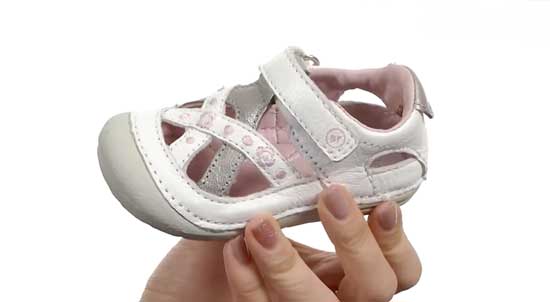
Key Features
- Available for toddlers.
- Order the shoe style Archie and Kiki on Amazon or Zappos.
- Available in wide and extra wide widths.
- Leather upper.
- Foam padding placed around the ankle collar and under the tongue for an incredibly comfortable fit and feel.
- I suggest that you get this shoe a half size larger than your toddler’s current foot size.
7. Shoe Style Martin by Stride Rite
The shoe features a wide toe box and plush cushioning, making it perfect for everyday wear. Parents often highlight the shoe’s ability to maintain its shape and support even after prolonged use, underscoring its durability.
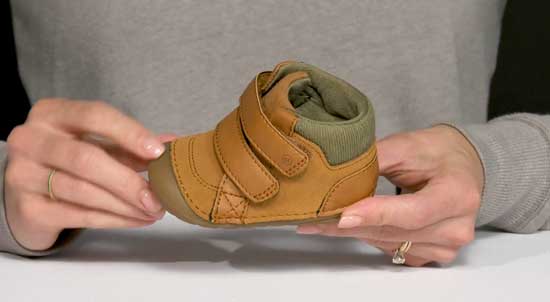
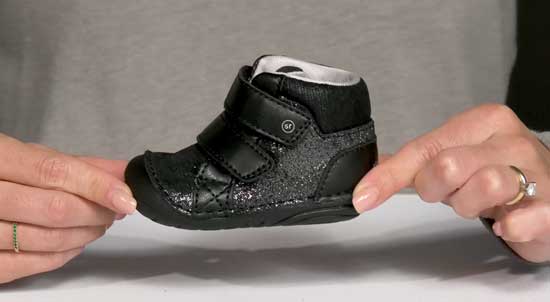
Key Features
- Available for toddlers, little, and big kids.
- Order the shoe style Martin by Stride Rite on Zappos.
- Available in wide and extra wide widths.
- I suggest that you get this shoe a whole size larger than your toddler’s current foot size.
8. Shoe Style Casey by See Kai Run
This See Kai Run bootie provides extra depth, rounded toe-boxes, and opens up nice and wide for easy on and off.
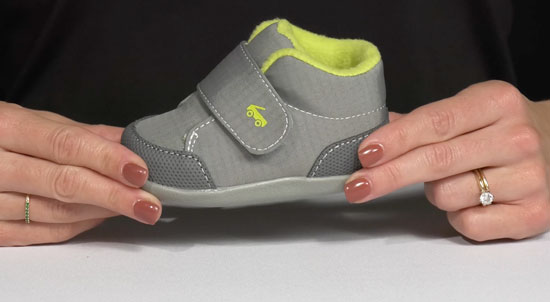
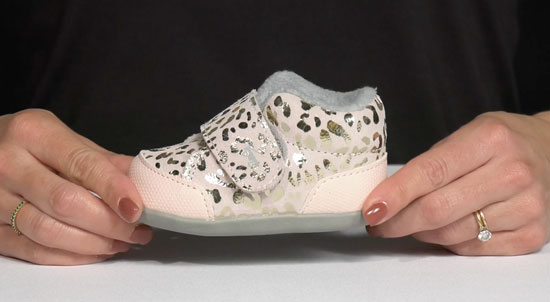
Key Features
- Available for toddlers.
- Order the shoe style Casey by See Kai Run on Amazon or Zappos.
- Not available in wide or extra wide widths but fits naturally wide.
- Awarded the Seal of Acceptance from the American Podiatric Medical Association (APMA).
- Fleece lining for extra warmth.
- I suggest that you get this shoe a whole size larger than your toddler’s current foot size.
9. Shoe Style Lucia by See Kai Run
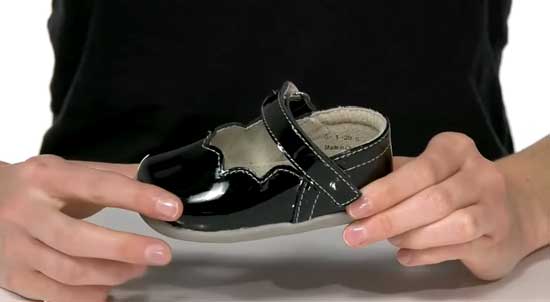
Key Features
- Available for toddlers.
- Order the shoe style Casey by See Kai Run on Amazon or Zappos.
- Not available in wide or extra wide widths but fits naturally wide.
- Awarded the Seal of Acceptance from the American Podiatric Medical Association (APMA).
- Fleece lining for extra warmth.
- I suggest that you get this shoe a whole size larger than your toddler’s current foot size.
10. Merrell Kids’ Bare Steps Sneaker
The Merrell’s Bare Steps sneaker is designed with a wide toe box and a barefoot feel, encouraging natural foot development. Its minimalist design allows for greater sensory feedback, which can enhance your child’s proprioception and coordination.
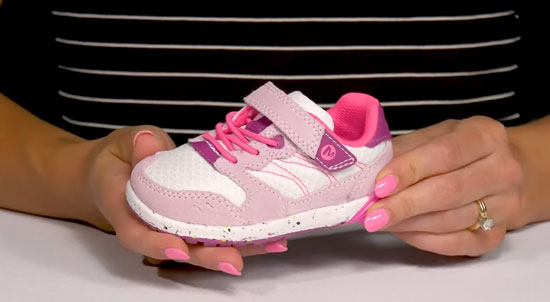
The Bare Steps Sneaker is also made from eco-friendly materials, aligning with Merrell’s commitment to sustainability. This makes it an excellent choice for environmentally conscious parents seeking quality footwear for their children.
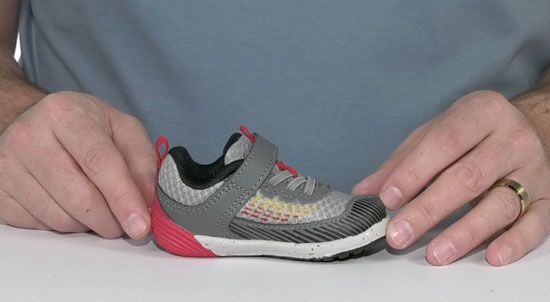
Key Features:
- Order the shoe style Bare Steps by Merrell on Amazon or Zappos.
- Not available in wide or extra wide widths but fits naturally wide.
- Awarded the Seal of Acceptance from the American Podiatric Medical Association (APMA).
- Padded tongue and collar for added comfort.
- I suggest that you get this shoe a whole size larger than your toddler’s current foot size.
Don’t worry if once you fit your toddlers into their first pair of shoes they have a hard time walking in them. Toddlers lose the sense that they have to the ground, so it feels a little strange and they might refuse to move. I just wanted to make you aware that this is totally normal.
Contact Me for a Personalized Shoe Recommendation
As a dedicated shoe fitter, my goal is to help parents navigate the world of toddler shoes with confidence. Remember, the right pair of shoes can make all the difference in your child’s walking journey, so I am happy to recommend specific shoes tailored to your toddler’s unique foot shape and walking stage:
fittingchildrensshoes@gmail.com
How to Order the Correct Shoe Size Online?
I recommend that parents take their toddlers who are learning how to walk to be properly fitted for shoes at their local children’s shoe store that they trust. The issue is that most local children’s shoe stores have been closing down, and parents don’t have a place to take their toddlers to be properly fitted for shoes.
For that reason, I created a virtual shoe fitting service that will help you retrieve your toddler’s shoe size from home. In that resource I help parents determine their toddler’s exact foot length and whether the child has narrow, medium, wide, or extra wide feet. I also will be able to tell you whether your toddler has a high instep or not.
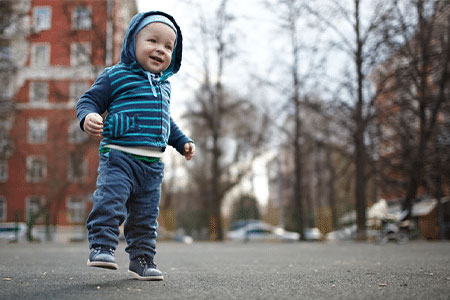
Are Nike and Adidas Good for Toddlers Learning How to Walk?
When it comes to popular brands like Nike and Adidas, parents often wonder if these are suitable for toddlers. While both brands offer stylish options that are hard to resist for their trendy looks and brand recognition, they may not always provide the necessary support for early walkers. The focus of these brands often leans more towards aesthetics and athletic performance rather than the specific needs of toddlers’ developing feet.
Seamless, Breathable, and Affordable Socks for Toddlers
There is one particular feature that I like the socks to provide and it’s for them to be seamless. Seamless socks are great for toddlers as they don’t constrict toe movement. Did you know that toddlers move their toes as a way of exercising their feet? That’s the reason why it’s so important for the socks to not constrict toe movement.
How to Find Out What Sock Size to Order for Your Toddler
When trying to find the correct sock size for your toddler, please ignore the label that reads “sock size” or “age guidelines”. To find your toddler’s correct sock size, you should always look under the label that reads “shoe size” in the socks’ tags. This is the most effective way to figure out your toddler’s correct sock size. Take a look at the image below for clarification:
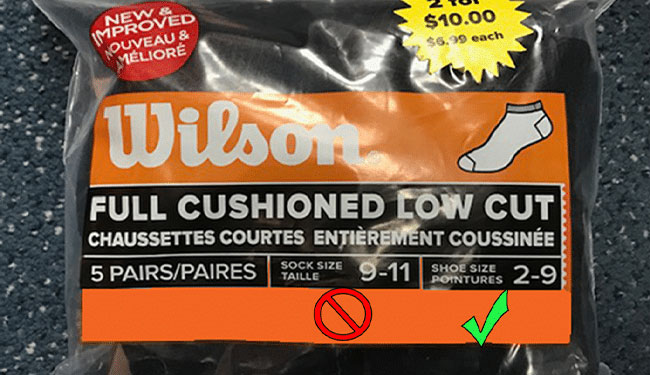
By understanding the importance of proper footwear and exploring the best brands and styles, you can ensure that your toddler’s first steps are comfortable and supportive.
Shoes for Toddlers Learning How to Walk – Watch Video!
I created a video that will help you better visualize what specific features your toddler’s first pair of walking shoes should provide.
Do you have a toddler who is learning how to walk and needs a pair of first walking shoes? Is there any particular shoe style that you have tried that has worked well for your toddler? Please let us know in the comments section below so other parents can benefit from your experiences.

